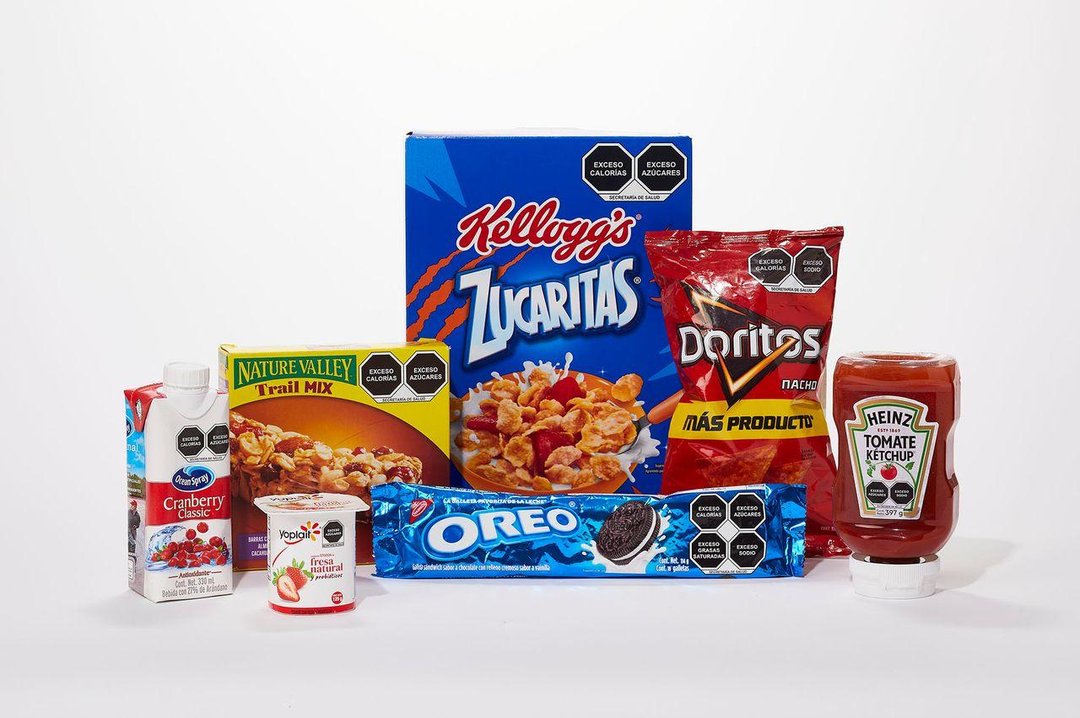
By Andrea Petersen and Jesse Newman
May 1, 2024
Would you still eat your snack if it came with a warning label?
As part of the government’s quest to improve American eating habits, the Food and Drug Administration is considering requiring food manufacturers to put new labels on the front of packages. The labels might flag certain health risks, such as high levels of salt, sugar or saturated fat.

Foods and drinks sold in Mexico feature warning labels on the front of packages if they are high in sodium, sugar, saturated fat and calories. PHOTO: F. MARTIN RAMIN/THE WALL STREET JOURNAL
Don’t expect to see a warning label in your grocery store soon, because the FDA is still weighing its approach. But the agency hopes that clearer food labeling could help us make healthier choices as it tackles the rise of diet-related health problems such as Type 2 diabetes and cardiovascular disease.
The food industry is pushing back, saying there isn’t enough evidence that labels can significantly change consumer behavior or that some labels under discussion are confusing.
What you would see on food packages
Most packaged foods in the U.S. already display a nutrition label, usually on the back or side. The new labels in consideration would be on the front of packages, according to the FDA, which says it intends to propose a rule on the labeling this summer.
One label idea the FDA has tested uses red, yellow and green to convey whether products are high, medium or low in added sugar, sodium and saturated fat. Other potential labels that the FDA has shared state how much of those substances a product contains per serving.
Chile, Mexico and other countries use stop-sign-shaped symbols that indicate an item contains, say, high levels of sugar. The labels appear on obvious treats like cookies, as well as many ketchups, yogurts and breakfast cereals.
These stark-looking warning labels are easier to understand than standard U.S. nutrition labels, researchers say.
“People are busy. You might have a toddler screaming at you. It’s really hard to interpret and make sense of all that information on the back of the pack,” said Lindsey Smith Taillie, a leading researcher on food labeling and associate professor at the University of North Carolina’s School of Public Health.
What the science says
Since 2022, the FDA has conducted focus groups and an experimental study using mock breakfast cereal, canned soup and a frozen meal to assess consumers’ ability to use different labels to evaluate the healthfulness of the foods.
Scientific studies have generally found that front-of-package nutrition labels lead people to identify and choose healthier foods. More countries now require them on food and beverage containers. Others, including France, the U.K. and Australia, have voluntary programs.
The ideal front-of-package label, Taillie says, is simple, visual and lets consumers easily assess how healthy a product is. In Mexico, a package of Oreos, for example, contains four octagon-shaped labels, one each for excess calories, sugars, saturated fats and sodium. (Mondelez, which makes Oreos, said it participates in many voluntary nutrition information programs in the U.S. and abroad, and that the company supports front-of-pack labels that draw on the latest science and dietary guidance.)
Early research has shown that the octagon-shaped warning labels, which are supported by some U.S. lawmakers, can change people’s shopping choices.
A Chilean law requiring labels on the front of food and drink packages resulted in people buying fewer products that now have warnings, says Camila Corvalán, professor of public health nutrition at the University of Chile, who helped develop the labels.
A large study of families’ food and drink purchases found that overall calories bought from products required to have warnings dropped by 23.8%, according to the study published in 2021 in the journal the Lancet Planetary Health. Overall sodium and sugar bought from those foods decreased by 36.7% and 26.7% respectively. The study analyzed food and drink purchases from more than 2,300 households from January 2015 to December 2017.
“People really want to know what they’re eating,” said Corvalán.
After the warning labels were implemented, food manufacturers changed their products, too—by reducing the amount of sodium or sugar, for example.
Food industry pushback
Stop-sign-like labels like Chile’s are anathema to many in the food industry, who worry that new mandatory labels could demonize products, according to industry lobbyists. Such labels could unfairly convey that certain foods are bad to eat, when in fact a candy bar may not be healthy, but consuming it in moderation isn’t a problem, lobbyists said.
The industry has warned the FDA it could sue to challenge mandatory front-of-package labels, saying that the labels could pose a threat to First Amendment rights and that only Congress has the authority to require them.
Existing nutrition labels offer consumers sufficient information, food industry groups say. Some companies voluntarily display labels on the front of food packages, providing information such as saturated fat and sodium levels, as well as calories and “nutrients to encourage,” such as fiber or calcium.
Industry groups have noted that new labels could appear to conflict with other federal dietary advice or confuse consumers. For example, both white and 100% whole wheat bread could be eligible for the same label despite nutritional differences, according to FMI, a trade group representing food retailers and suppliers. The industry is also pushing the agency for black-and-white labels rather than colors, especially red.
“A whole grain cereal that is high in fiber may have a red colored label because of some added sugar to make it more palatable,” said Kellogg in a letter to the FDA this past year. (Kellogg has since split into two companies.) “If a consumer is only paying attention to the red on the label, they might avoid the product and miss out on the cereal’s benefits.”
An FDA official said the agency’s work is ongoing, and noted that it has broad authority over labels on food.
Lessons from one country
In Mexico, which began requiring warning labels similar to those in Chile in 2020, some food companies have gotten creative. Some cereal boxes now have nearly identical fronts and backs—and the “back,” without the warning label, is placed forward on store shelves, according to Simón Barquera, director of the nutrition and health research center at the National Institute of Public Health of Mexico, who helped develop and evaluate the label program.
“They find loopholes,” says Barquera.
There are indications that food manufacturers are making their products healthier to avoid labels, Barquera says. Most packaged cereals are no longer high in sodium, he notes. And consumers’ knowledge about which foods are healthy is increasing, he adds.
“I think most people knew that things like potato chips were junk food,” says Barquera. “But many people thought ready-to-eat cereals were healthy. And now they know it’s expensive junk food.”
Write to Andrea Petersen at andrea.petersen@wsj.com and Jesse Newman at jesse.newman@wsj.com
Dow Jones & Company, Inc.


